Texas Style Smoked Beef Brisket
On June 11, 2019 (Updated September 06, 2022)
This post may contain affiliate links. Please read our disclosure policy.
Texas Style Smoked Beef Brisket is more than a simple recipe, it’s a process for melt in your mouth smoked brisket. All you need is salt, pepper, smoke, and time, and you’re on your way to eating the best beef brisket of your life.
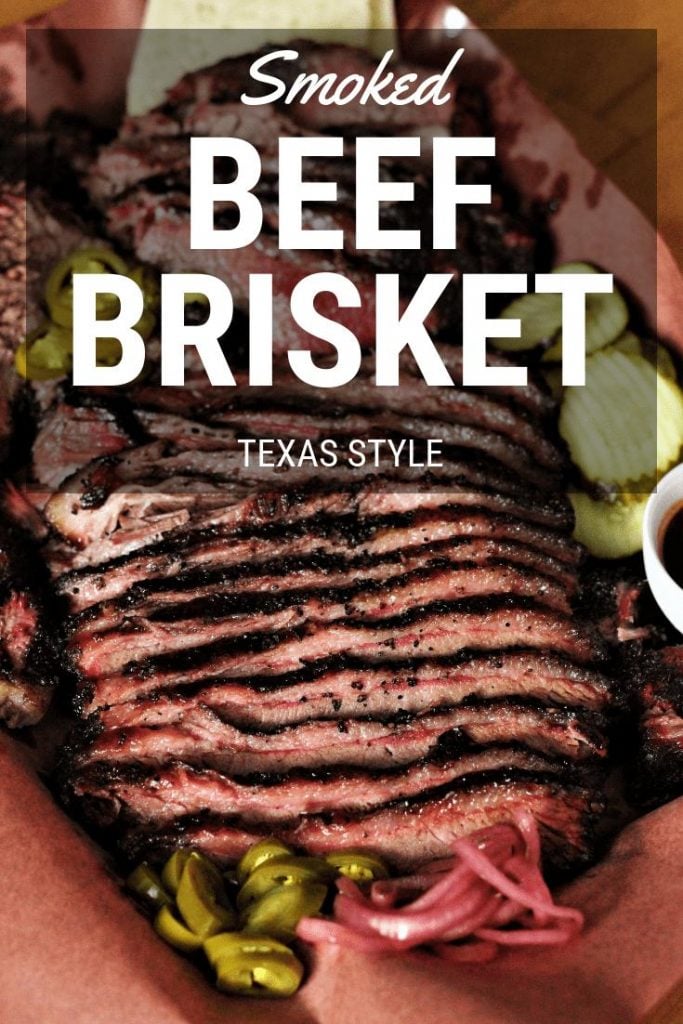
Smoked Brisket
I totally understand how intimidating it can be to smoke a huge, expensive brisket for the first time. That’s why I’ve tested and re-tested many different methods and recipes to help you achieve perfect results every time using a relatively simple process.
Once you try this juicy brisket, you’ll be itching for the next opportunity to smoke another one. BBQ (especially brisket) is something you have to learn by experiencing it yourself, so let’s jump in and give it our best go!
Tools Needed to Smoke Brisket
I have linked the products that I use when smoking my brisket below so you can see exactly what I’m using at home. Not all of these are necessary, but after smoking a bunch of briskets, I have found they make the job a lot easier!
- Smoker. I like to use my CampChef SmokePro, but any variety that can hold a steady temperature of 225 degrees F will work great.
- Large Cutting Board. You’ll need a big surface to slice your hunk of brisket on once it’s ready to serve.
- Meat Thermometer. The Thermapen Mk4 is the perfect thermometer for this brisket, but any reliable thermometer will do.
- Butcher Paper. This Texas style brisket is wrapped in butcher paper during the stall. You can pick up some Hey Grill Hey Peach Butcher Paper over at Patio Provisions today!
- Chef’s Knife. A good, sharp knife is necessary to slice your brisket. This Dahstrong Chef Knife is perfect for the job.
How to Smoke a Brisket
Smoking brisket isn’t hard, it just takes time, and lots of it! Follow the steps below to get the best smoked brisket of your life:
- Select your brisket. I have a full write up about choosing the perfect brisket in my Brisket 101 post. Here are the basics: Plan on purchasing a whole packer brisket with both the point and flat muscle included. The grade of your meat matters, prime beef will have more fat marbling. (This means more flavor and juiciness than a choice graded brisket!). Buy about 1/2 pound (or more) of brisket per person you are serving.
- Trim the brisket. Some Texans claim they don’t trim at all. At most of the top smokehouses, however, they do trim. This step is so important for how the final product will turn out. Spend the 20-30 minutes you need to trim it properly. I have step by step instructions (and pictures) for trimming your brisket in this post: How To Trim a Brisket. There is also a sped-up version in the video (below the recipe card) that will help you get a visual for a trimmed brisket.
- Season your brisket. Texas style is seasoned with only coarse salt and coarse black pepper. My only addition (and this is personal preference, you can skip it if you’re a purist) is to add garlic powder as well. It doesn’t really change the flavor or take away from that amazing smoked beef, but adds a little extra layer of goodness.
- Get Smoking! Use a nice hardwood in your smoker. I used oak as the base wood with a little bit of cherry mixed in. The goal here, whatever type of smoker you are using, is consistent heat and a steady flow of thin blue smoke.
- Wrap the brisket. This is one of the most crucial steps, in my opinion, to achieving that super juicy tender brisket with that killer dark caramelized bark. Opinions differ between using foil and peach butcher paper, but for this recipe I am fully converted to the butcher paper after years of using foil. My briskets have never had a better smoke flavor and a more delicious bark.
The brisket gets wrapped up like a present, folding edge over edge until it is fully sealed. Return the brisket to your smoker with the folded edges down and continue smoking at 225 degrees F until the internal temperature of your brisket reaches 202 degrees F at the thickest part (make sure your thermometer is in the meat, not fat).
- Rest your smoked brisket. DO. NOT. SKIP. THIS. STEP. Resting your brisket allows so many of those hot and bubbly juices to settle down a little and redistribute to the meat. It also brings your brisket down to perfect slicing and serving temperature.
- Slice your brisket. I have a full post about slicing your brisket HERE. You want to slice your smoked brisket against the grain for maximum tenderness. But remember! There are two overlapping muscles and two different grain directions. You can split the point and flat sections and slice each individually against the grain before serving but that sometimes leaves pieces with no bark on top. Traditional Texas joints split the brisket down the middle, as close as possible where to point overlaps the flat, they then turn the point 90 degrees and slice it that way and then finish slicing the flat the opposite way. You will have some pieces where they grain isn’t perfect but if your meat is tender enough it won’t matter too much.
- Serve your gorgeously smoked brisket. In Texas joints when you order, you can request fatty or lean brisket. The fatty is the point and the lean is the flat. I like to tell my guests which slices are which so they can pick their favorite. The fatty is my personal preference, but I always grab a slice of the lean too because it has such an amazing smoke flavor! For an even more traditional experience, serve on a platter with butcher paper, lots of pickles, white bread, picked red onions, and pickled jalapenos. Sauce on the side. Always.
How Long to Smoke a Brisket
I wish I could tell you an exact time that smoking will take, but alas, that’s kind of the beauty of BBQ. It’s done when it is done.
For the initial smoke phase, I plan about 8 hours at 225 degrees F for my 12-13 pound briskets to reach 165 degrees F. However, your brisket will enter a phase in between 145 degrees F and 165 degrees F where the liquid evaporating from the surface of the brisket will cool it while your grill is trying to cook it. This is called the stall, and the time frame is different during this phase for every brisket I’ve ever cooked. This is where a good internal thermometer comes in.
The second phase (once it’s wrapped in butcher paper), can take anywhere from 5-8 hours. I usually plan an extra 2 hours for each of my brisket cooks because if it is done early, I can always set it in a cooler and allow it to rest for a while. If it is done late my husband gets hangry.
Bottom line: plan for anywhere from 12-18 hours to fully cook your brisket (this includes the initial smoke to 165 degrees and the wrapped smoke to get your meat up to 202 degrees Fahrenheit).
Tips for the Best Smoked Beef Brisket
Check out these pro tips to give you the upper hand when smoking your brisket:
- Mix your spices in advance. Mix your salt, pepper, and garlic in an old spice shaker container. Shake the spices out at about 2 feet above your brisket while seasoning. This will create a nice even layer of salt, pepper, and garlic across the entire surface of your brisket.
- Either side up cooks just fine! Many people argue whether you should cook your brisket with the fat side up or down when smoking. Guess what? I did two briskets, one up and one down. There was no difference in final product. Place it on there however you prefer!
- Don’t forget to rest! Resting your brisket is extremely important. I recommend resting your brisket for at least one hour. You can just leave it in the butcher paper and set it on a cutting board or baking sheet. If you need to rest your brisket for more than an hour, that is no problem! Simply wrap it in a towel (one you don’t mind sacrificing for tasty brisket) and set it in an insulated cooler. I’ve held briskets this way for up to 6 hours and they come out hot and perfect every time!
Variations for Smoked Brisket
Not all brisket methods are the same, and I often try different techniques to get the best results. Here are a couple of variations you can try:
- Slather! Some people like to use a binder to help the rub adhere to the brisket. My favorite is yellow mustard. This helps the seasoning stick, but the acidity also helps break down the surface of the meat and create a gorgeous bark. It’s not necessary, but worth a try to see if you like it!
- Wrap! I recommend wrapping in butcher paper, but foil is also an option. In fact, foil is the original Texas crutch to help push smoke dmeat through the stall. It’s still used in many BBQ joints. Your brisket may have a softer bark, but it will maintain a lot of moisture inside the meat itself.
- Temperature! I like low and slow for my briskets, but some people like the process to hurry a long a bit. You can try smoking at 275 degrees F to shorten the cook time. There’s no perfect formula to have a perfect time line, so keep an eye on the internal temp of your brisket.
Smoked Brisket Recipe
Watch the video below the recipe card and I’ll show you step-by-step how I make this smoked brisket at home. I’m on a mission to help you become the best backyard BBQer of your life, so head on over to YouTube, Instagram, or Facebook to get more recipes, videos, and tips from Hey Grill Hey. We can’t wait to hear from you!
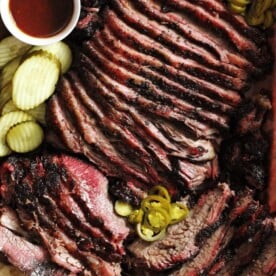
Texas Style Smoked Beef Brisket
Video
Equipment
- 1 Smoker I highly recommend this pellet grill!
Ingredients
- 1 12-14 pound whole packer brisket
- 2 Tablespoons coarse Kosher salt
- 2 Tablespoons coarse ground black pepper
- 2 Tablespoons garlic powder (optional)
Instructions
- Store your brisket in the refrigerator until you are ready to start trimming. Cold briskets are much easier to work with. Flip your brisket over so the point end is underneath. Remove any silver skin or excess fat from the flat muscle. Trim down the large crescent moon shaped fat section until it is a smooth transition between the point and the flat. Trim and excessive or loose meat and fat from the point. Square the edges and ends of the flat. Flip the brisket over and trim the top fat cap to about 1/4 of an inch thickness across the surface of the brisket.
- In a mixing bowl or empty spice container, mix the salt, pepper, and garlic. Share over the brisket to evenly distribute the spices on all sides.
- Preheat your smoker to 225 degrees F using indirect heat and hardwood smoke. Place the brisket on the smoker with the point end facing your main heat source. This is a thicker part of the brisket and it can handle the additional heat. Close the lid and smoke until and internal thermometer reads 165 degrees F (usually takes around 8 hours).
- On a large work surface, roll out a big piece of butcher paper (or foil) and center your brisket in the middle. Wrap the brisket by folding edge over edge, creating a leak proof seal all the way around. Return the wrapped brisket to the smoker, seam side down so the weight from the brisket crimps the edges of the paper wrap down tight.
- Close the lid on the smoker and, maintaining 225 degrees F, continue cooking until the internal temperature of the brisket reaches 202 degrees F in the thickest part of the meat (takes anywhere from 5-8 hours).
- Remove the brisket to a large cutting board and allow to rest for 1 hour before slicing. Slice both the point and the flat against the grain with a sharp knife and serve immediately.
Nutrition
Nutrition information is automatically calculated, so should only be used as an approximation.
**This recipe was originally published June 2017. It has since been updated and republished January 2019.
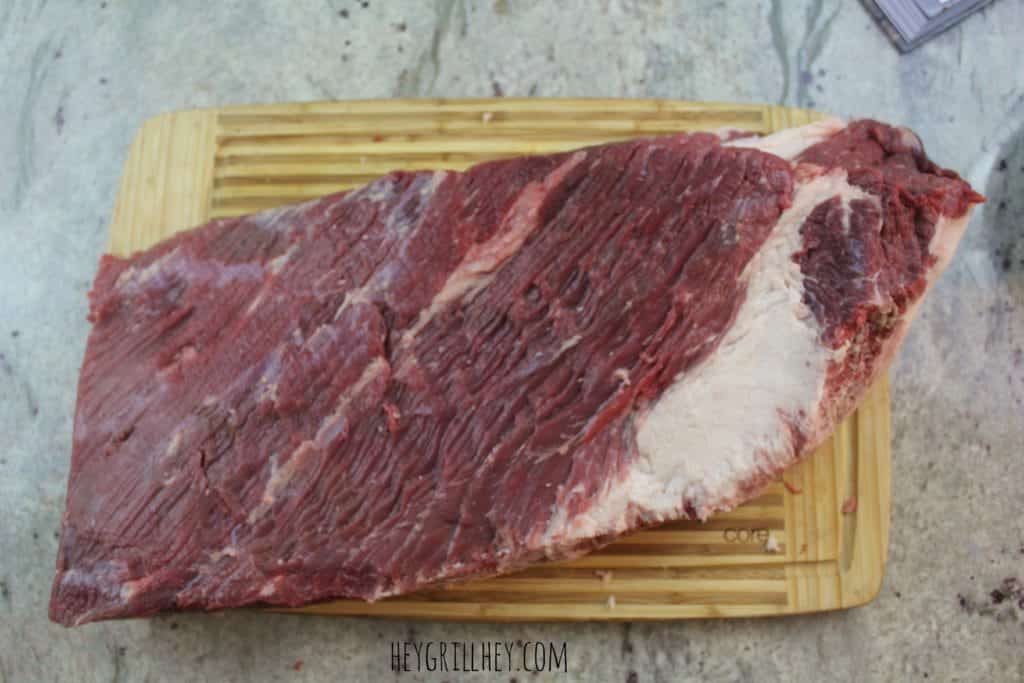
 The brisket gets wrapped up like a present, folding edge over edge until it is fully sealed. Return the brisket to your smoker with the folded edges down and continue smoking at 225 degrees F until the internal temperature of your brisket reaches 202 degrees F at the thickest part (make sure your thermometer is in the meat, not fat).
The brisket gets wrapped up like a present, folding edge over edge until it is fully sealed. Return the brisket to your smoker with the folded edges down and continue smoking at 225 degrees F until the internal temperature of your brisket reaches 202 degrees F at the thickest part (make sure your thermometer is in the meat, not fat).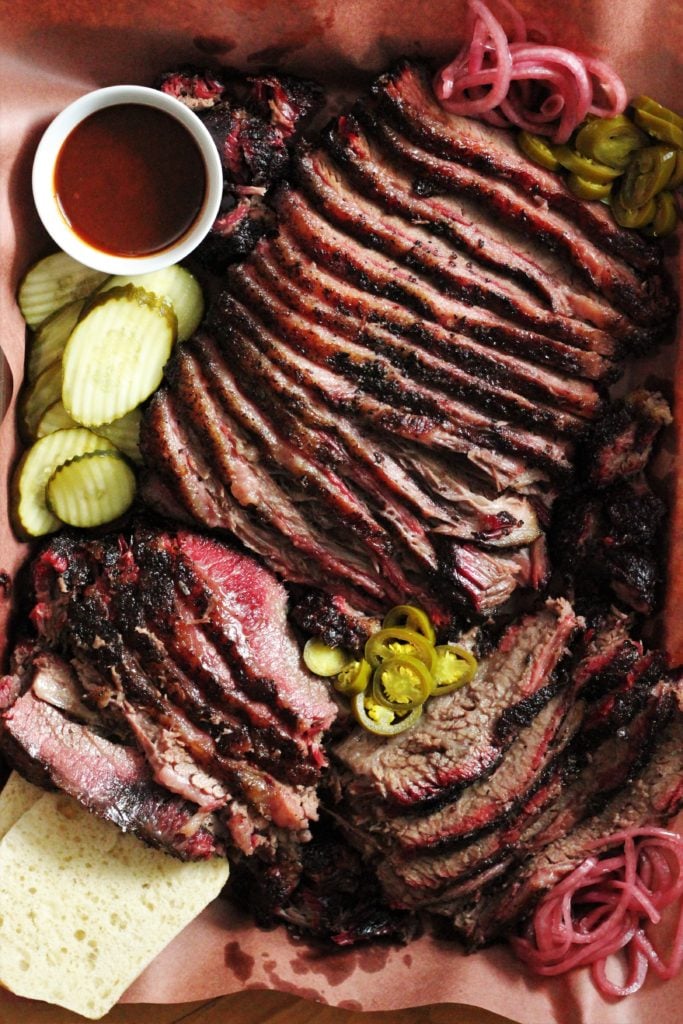
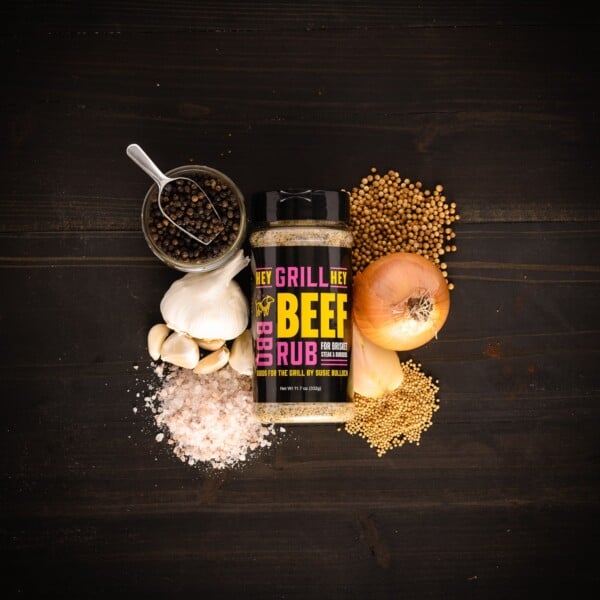


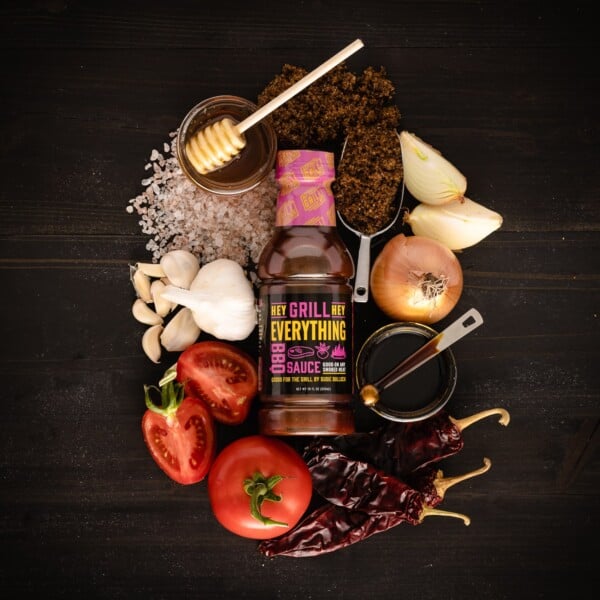

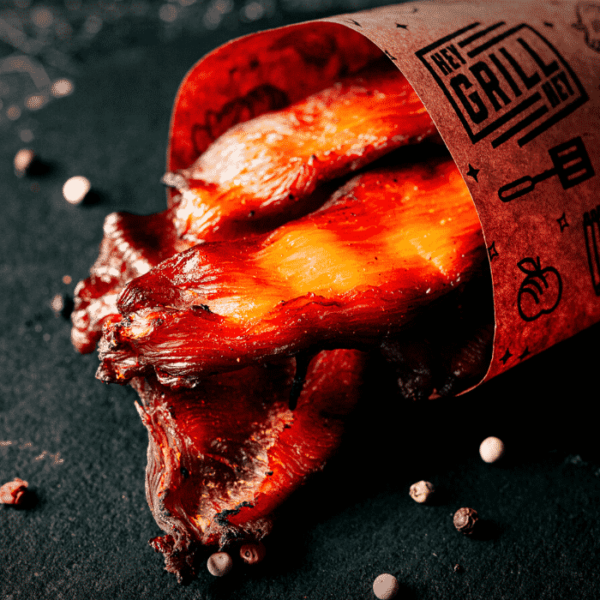
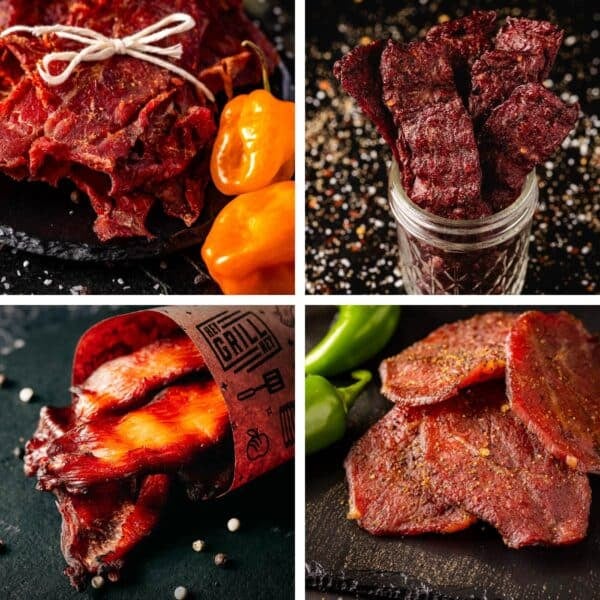

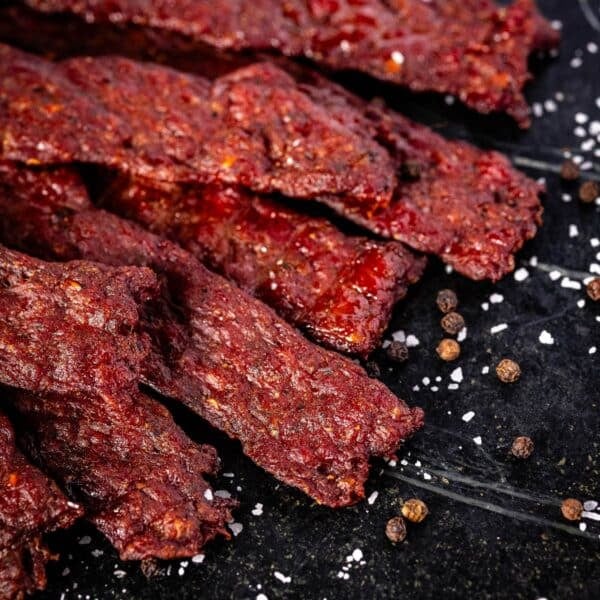





Question: weekend will be very busy but I can’t wait to make this brisket. Any chance I could do the pre-wrap smoking one day, put it in the fridge when we have to leave plus overnight and then finish with the wrapped part the next day?
It wouldn’t really work that way. What I would do is smoke the brisket until it was done, let it rest for a while and put it in the fridge. Reheat on a lower temp setting in your oven wrapped in foil.
Used your instructions to make my first brisket for my Father in Laws Birthday. I was nervous because he is a brisket snob, but it came out perfect now he is asking me when I am going to be cooking for him again.
My Masterbuilt smoker has a water tray, as I’m sure most have, but when do I use it? With what meats, how much, etc.?
You don’t have to use it at all. I usually only put water in with longer cooks, and when the relative humidity outside is pretty low.
I just got a wood pellet smoker and this was my first time ever smoking meat. I’m a Texan stranded in seattle and you cannot get any good bbq. Anything OK will cost you +$20 for a wimpy plate.
After lots of research, found your website and used it as my guide to smoke my brisket. I have my own rub recipe which I used the evening before. Woke up at 5am to begin smoking. Followed all your instructions, including wrapping with peach paper. 8 hours to get to 165 and another 4 to get to 195 which I based on other research was identified to be an ideal time to pull out the brisket to let it rest. IT WAS PERFECT! I was so please with myself and made my husband sing my praises. My son was also thoroughly impressed with my skills.
My husband even helped me clean the smoker that evening which he originally said he would not do if I proceeded with buying a smoker. LOL clearly my meat was so good he was persuaded to help.
So glad I found your website. I know way more than I did about brisket and smoking meat.
That’s so awesome! Way to nail it! Maybe he’ll always clean it now.
Great brisket! Every time I follow your recipes to a T, they come out excellent. We had a few hiccups, so this comment is for readers that have “things happen”
I set my alarm for 12PM instead of 12AM, so i wasn’t able to start the smoke until 3:30am ????
Our 15lb (pretrimmed) brisket took about 8.5 hours to reach 160. We wrapped it and continued the smoke at 225 for another 2 hours. At this point I realized that it was cooking very slowly and my oversleeping was going to cost me!
We couldn’t really delay dinner by too long, as there was family in town and young kids involved.
I cranked it to 275 for 3 hours, and had to increase to 325 for the last hour to reach 204. Total smoke and cook time was over 14 hours.
The point was like crack, and the flat was very good but was not as tender as it should have been. All in all very happy but look forward to allowing a full 18 hours next time
In short, if you have to crank the temperature, don’t worry it will still be good. But if you can, plan for an 18 hour smoke.
Hi Susie! Been following your recipes for years, and love getting my weekly email from you!
So – this is my all-time favorite brisket recipe, but I completely screwed up the timing yesterday. I always put it in very late at night for an overnight cook, typically pulling it off of the smoker mid afternoon. but this time the brisket was done (202) at 10 a.m., and we didn’t eat till around 5. I had it wrapped in foil, towels and in a cooler, thinking it would be okay after that long. I was really disappointed to unwrap it and slice it only to discover it had dried out far more than I thought was possible being all snuggled up like that. Do you have any guidelines on how long is too long to leave a finished brisket before eating it? Or any tips to rehydrating it a little bit if that does happen? Thanks!
Every brisket is different, for sure, but that is a super fast cook time. I wonder if your smoker was running hotter than you thought? Do you have a clean thermometer probe near your grill grates? The quick cook may have contributed to the dry brisket.
I had a 3 pound flat from Costco and used a Camp Chef pellet smoker. It took a couple of hours to get to 165, then I wrapped it, and then it took 9 MORE HOURS to get to 200. The finished product was quite dry. So what went wrong? I followed the instructions to a T.
What temperature was your smoker set at? Also, did you use a thermometer on the grill grate to verify the accuracy of the temperature setting?
I’m using a Weber Smokey Mountain with a Costco point mentioned several times above (yes, I read the entire thread…). For other types of meat there seems to be a difference in which rack to use. While it seems like the top rack would collect more heat, the lower rack is closer to the source, although the water pan is in between. Any thoughts as to whether this might affect a brisket?
I would do a dry run and see what position gives you the most stable and closest temperature to where you want to be and put it there!
There are just two of us and we will be trying a 4 pound brisket. It seems that we should follow the temperature as a guide, instead of time. We think that since this is a third of your recipe size our time should total around 6 hours. What do you think?
That sounds about right! If it gets done a little earlier, wrap it in towels and place it in a cooler to keep it warm until you’re ready to eat!
I will be doing my 1st brisket this week, one question is do you wrap the brisket initially or about 1/2 thru, don’t understand how it gets the smoke bark if it is wrapped in tin foil in the beginning, help please.
You wrap it later in the cook. It’ll stall around 140 degrees or so and the wrap will help you get through that period and finish it off!